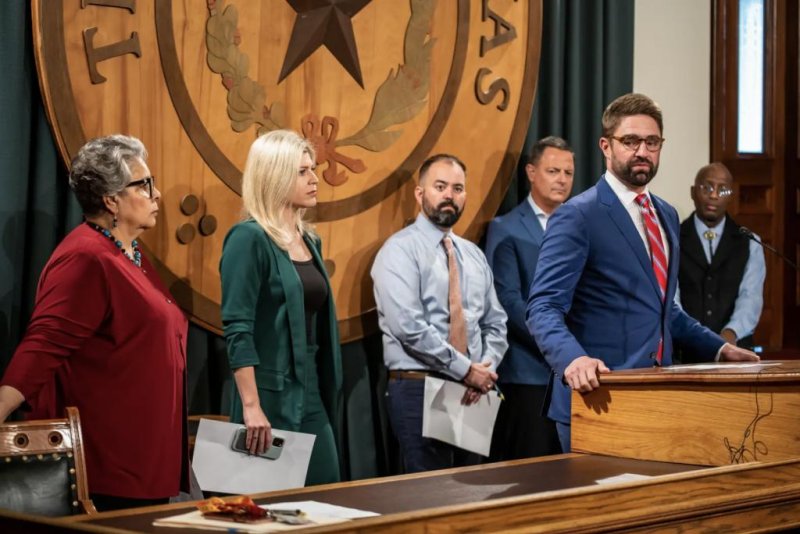By NEBI QENA and CARA ANNA

1 of 21
KYIV, Ukraine (AP) — Ukraine accused Moscow on Thursday of forcibly taking hundreds of thousands of civilians from shattered Ukrainian cities to Russia, where some may be used as “hostages” to pressure Kyiv to give up.
Lyudmyla Denisova, Ukraine’s ombudsperson, said 402,000 people, including 84,000 children, had been taken to Russia.
The Kremlin gave nearly identical numbers for those who have been relocated, but said they wanted to go to Russia. Ukraine’s rebel-controlled eastern regions are predominantly Russian-speaking, and many people there have supported close ties to Moscow.
A month into the invasion, the two sides traded heavy blows in what has become a devastating war of attrition. Ukraine’s navy said it sank a large Russian landing ship near the port city of Berdyansk that had been used to bring in armored vehicles. Russia claimed to have taken the eastern town of Izyum after fierce fighting.
At an emergency NATO summit in Brussels, Ukraine President Volodymyr Zelenskyy pleaded with the Western allies via video for planes, tanks, rockets, air defense systems and other weapons, saying his country is “defending our common values.”
U.S President Joe Biden, in Europe for the summit and other high-level meetings, gave assurances more aid is on its way, though it appeared unlikely the West would give Zelenskyy everything he wanted, for fear of triggering a much wider war.
Around the capital, Kyiv, and other areas, Ukrainian defenders have fought Moscow’s ground troops to a near-stalemate, raising fears that a frustrated Russian President Vladimir Putin will resort to chemical, biological or nuclear weapons.
In other developments Thursday:
—Ukraine and Russia exchanged a total of 50 military and civilian prisoners, the largest swap reported yet, Ukrainian Deputy Prime Minister Iryna Vereshchuk said.
—The pro-Moscow leader of Belarus, Alexander Lukashenko, warned that Poland’s proposal to deploy a Western peacekeeping force in Ukraine “will mean World War III.”
—In Chernihiv, where an airstrike this week destroyed a crucial bridge, a city official, Olexander Lomako, said a “humanitarian catastrophe” is unfolding as Russian forces target food storage places. He said about 130,000 people are left in the besieged city, about half its prewar population.
—Russia said it will offer safe passage starting Friday to 67 ships from 15 foreign countries that are stranded in Ukrainian ports because of the danger of shelling and mines.
Kyiv and Moscow gave conflicting accounts, meanwhile, about the people being relocated to Russia and whether they were going willingly — as Russia claimed — or were being coerced or lied to.
Russian Col. Gen. Mikhail Mizintsev said the roughly 400,000 people evacuated to Russia since the start of the military action were from the Donetsk and Luhansk regions in eastern Ukraine, where pro-Moscow separatists have been fighting for control for nearly eight years.
Russian authorities said they are providing accommodations and dispensing payments to the evacuees.
But Donetsk Region Gov. Pavlo Kyrylenko said that “people are being forcibly moved into the territory of the aggressor state.” Denisova said those removed by Russian troops included a 92-year-old woman in Mariupol who was forced to go to Taganrog in southern Russia.
Ukrainian officials said that the Russians are taking people’s passports and moving them to “filtration camps” in Ukraine’s separatist-controlled east before sending them to various distant, economically depressed areas in Russia.
Among those taken, Ukraine’s Foreign Ministry charged, were 6,000 residents of Mariupol, the devastated port city in the country’s east. Moscow’s troops are confiscating identity documents from an additional 15,000 people in a section of Mariupol under Russian control, the ministry said.
Some could be sent as far as the Pacific island of Sakhalin, Ukrainian intelligence said, and are being offered jobs on condition they don’t leave for two years. The ministry said the Russians intend to “use them as hostages and put more political pressure on Ukraine.”
Kyrylenko said that Mariupol’s residents have been long deprived of information and that the Russians feed them false claims about Ukraine’s defeats to persuade them to move to Russia.
“Russian lies may influence those who have been under the siege,” he said.
As for the naval attack in Berdyansk, Ukraine claimed two more ships were damaged and a 3,000-ton fuel tank was destroyed when the Russian ship Orsk was sunk, causing a fire that spread to ammunition supplies.
Zelenskyy rallied the country to keep up its military defense in hopes it would lead to peace.
“With every day of our defense, we are getting closer to the peace that we need so much. We are getting closer to victory. … We can’t stop even for a minute, for every minute determines our fate, our future, whether we will live,” he said late Thursday in his nightly video address to the nation.
Zelenskyy said thousands of people, including 128 children, have died in the first month of the war. Across the country, 230 schools and 155 kindergartens have been destroyed. Cities and villages “lie in ashes,” he said.
Sending a signal that Western sanctions have not brought it to its knees, Russia reopened its stock market but allowed only limited trading to prevent mass sell-offs. Foreigners were barred from selling, and traders were prohibited from short selling, or betting prices would fall.
Millions of people in Ukraine have made their way out of the country, some pushed to the limit after trying to stay and cope.
At the central station in the western city of Lviv, a teenage girl stood in the doorway of a waiting train, a white pet rabbit shivering in her arms. She was on her way to join her mother and then go on to Poland or Germany. She had been traveling alone, leaving other family members behind in Dnipro.
“At the beginning I didn’t want to leave,” she said. “Now I’m scared for my life.”
___
Anna reported from Lviv, Ukraine. Associated Press writers Robert Burns in Washington, Yuras Karmanau in Lviv and other AP journalists around the world contributed to this report.
___
Follow the AP’s coverage of the war at https://apnews.com/hub/russia-ukraine









/https://static.texastribune.org/media/files/cdaa466923c506c2a140442939025a3e/IP-Melissa-Lucio%20TT%2003.jpg)



